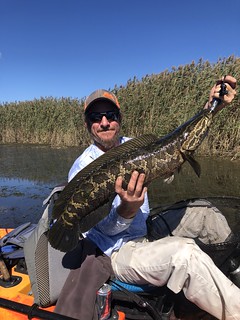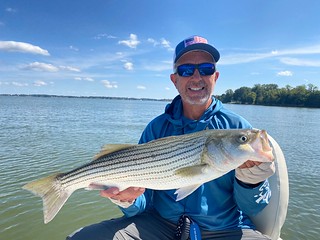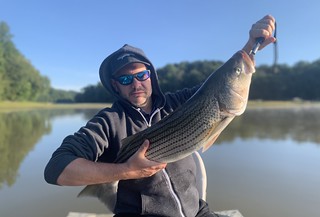Maryland Fishing Report – October 6

Lyla Jones went fishing last weekend with her dad and grandfather (along with a a furry friend) and they all had a wonderful time together. Photo by Joe Garrett
Early fall offers a wonderful opportunity to spend time outdoors with family and friends, especially our younger anglers. The fall trout stocking program has begun, offering excellent trout fishing at waters in most areas of Maryland. The Atlantic waters near Ocean City and Assateague Island, along with the Coastal Bays and the Chesapeake Bay all offer wonderful fishing opportunities before colder weather begins to move in next month.
Forecast Summary: October 6 – October 12:
It’s another great week to get out and enjoy Maryland’s fall foliage and Chesapeake Bay waters. Aside from possible rain on Saturday and Sunday, expect sunny and calm conditions during the day and cool nights for the week. Bay surface water temperatures are holding in the lower 70s. The improving oxygen and water temperature conditions will continue to provide anglers great opportunities to catch fish in shallower waters and the traditional places deeper in the water column such as channel edges, underwater points, hard bottom, and dropoffs.
Bay oxygen conditions continue to improve for gamefish. Adequate oxygen levels are found at all depths from the Susquehanna Flats to Still Pond and at Swan Point. Due to low bottom oxygen levels, avoid fishing below the following depths in these locations: Bay Bridge to Bloody Point, 25 feet to 45 feet; Choptank River to Point No Point, 25 feet to the bottom. On the Potomac River from Colonial Beach to Piney Point, there is suitable oxygen 20 feet to the bottom. Conditions can vary daily so be sure to check the depth-to-oxygen level online for your specific location prior to your next fishing trip.
Expect normal flows for most Maryland rivers and streams. Susquehanna River flows are running higher than normal. There will be above average tidal currents through Monday as a result of the Oct. 6 new moon.
Expect average clarity for many of the Maryland portions of the Bay and rivers, except the middle Patuxent, Bush, and Back rivers. To see the latest water clarity conditions, check Eyes on the Bay Satellite Maps.
For more detailed and up-to-date fishing conditions in your area of the Bay, check the Maryland DNR website for Click Before You Cast. Get regular updates on Maryland’s waters sent to your inbox with our Eyes on the Bay newsletter. Sign up online.

Don Goff holds up one of several northern snakeheads he caught recently while casting from his kayak near the mouth of the Gunpowder River. Photo courtesy of Don Goff
At the top of the Bay, anglers are still seeing stained water conditions but report that the water is steadily clearing. Additionally there is still wood floating about due to high water the last week of September, so be careful when boating. Water temperatures in the lower Susquehanna River are holding around 67 degrees this week. Many anglers looking for some action are fishing for a mix of blue and channel catfish at the mouths of the Susquehanna and Elk rivers as well as the Tolchester Lumps area. Others are fishing the shallows on the eastern side of the Bay where waters are clearer. Casting paddletails near the mouths of the Sassafras and Bohemia rivers has been producing some striped bass action in the morning and evening hours.
Casting paddletails and similar lures for striped bass can also attract the attention of northern snakeheads, which now inhabit most tidal rivers and creeks in the upper Bay. Grass beds are beginning to diminish and the snakeheads will be found near existing grass edges.
Down the Bay there is striped bass action being found at the Love Point rocks, the mouth of the Magothy River, and the Bay Bridge piers. Anglers are jigging, live-lining spot and eels, and drifting cut menhaden and soft crab baits near the Bay Bridge pier bases with good success.
Many anglers are reporting that white perch fishing has not been quite up to what they expect in the early fall. Those casting beetle spins and a variety of similar lures along shoreline structure in the morning and evening hours are catching enough to make them happy. The typical fall pattern is for white perch to move deep in the lower parts of the tidal rivers, and hold over hard bottom such as oyster bars until they make their final move to deep channel areas for the winter months.

Herb Floyd holds up a nice chunky striped bass he caught in the lower Choptank River. Photo courtesy of Herb Floyd
Anglers are now seeing a mix of striped bass and small bluefish chasing schools of bait in the main part of the Bay. The schools of bait usually consist of bay anchovies and juvenile menhaden. The bait is often swept along in the strong tides along channel edges, so keep your eyes open for diving seagulls and breaking fish. This is a marvelous time of the year to be out fishing for striped bass. When jigging it is hard to beat a fast-action rod and a reel loaded with braid. The striped bass are quickly responding to cooler water temperatures and aggressively feeding, building up body stores and developing the deep rich colors of a healthy striped bass.
There are still a few Spanish mackerel but they tend to be few and far between for those casting into breaking fish. Most who are trolling have kicked the throttle back a bit and are trolling a mix of small spoons, swimshads, and bucktails dressed with soft plastic curlytails. Umbrella rigs are a very popular choice in the fall behind inline weights, which help get them down to where fish are holding along deep channel edges.
The shallow-water fishery for striped bass is very good in the morning and evening hours along the Bay shores and lower sections of the region’s tidal rivers. Casting poppers and paddletails is a fun light-tackle way to fish for striped bass, and lately it has been very productive.
White perch are beginning to move from their typical summer habitat to the deeper waters of the tidal rivers. There are still some that can be found in the shoreline structure areas, and they can be caught by casting a mix of beetle spins, spinners, small spinnerbaits, and soft plastic curlytails. Bottom rigs baited with pieces of bloodworms or razor clams or dropper rigs with small soft plastics are a good way to target them when they are holding in deeper waters over oyster bottom.
A final reminder to bay anglers that the annual Chesapeake Bay Foundation Rod and Reef Slam begins Saturday, October 9, and runs until Sunday, October 17. Instead of focusing on catching the biggest fish, prizes will be awarded for how many species you catch as well as size. Register for the Slam on the CBF website.
Anglers are finding a healthy mix of striped bass and small to medium sized bluefish throughout most of the main portion of the lower Bay and the lower sections of the tidal rivers. Anglers are trolling umbrella rigs with swimshad and bucktail trailers, and unfortunately for some the bluefish are busy nipping off the tails of the swimshads. Where bluefish abound, many are going to 3-inch swimshads or switching to small spoons.
Jigging along channel edges with skirted soft plastic jigs or metal is working well this week for striped bass suspended along channel edges or deep under breaking fish. Diving seagulls, slicks, and a careful watch on depth finders often lead the way to concentrations of striped bass. A fair portion will measure under 19 inches as is common in other regions of the Bay, but larger fish are mixed in. It pays to keep a heavy spinning rod or conventional setup with a large spoon or jig in case large red drum are spotted on the depth finder, there are still some of these beasts around in our waters.
Working the shorelines of the Bay and lower sections of the tidal rivers is a great way to enjoy some light-tackle fishing. Most anglers are having good success by casting poppers or paddletails along likely-looking shoreline structure in the mornings and evenings during a moving tide. The lower Patuxent and Potomac rivers are a good place to fish this way, as are the Hooper Island cuts and nearby shorelines. Striped bass are what is mostly being caught, along with bluefish and a speckled trout now and then. In the Tangier Sound area some very large speckled trout are being targeted and caught. Casting paddletails along shorelines and stump fields or drifting soft crab baits at the mouths of marsh creeks is a good way to target them.
There are still spot holding in the lower Patuxent and Potomac rivers this week along with plenty of white perch. The spot are about as large as they’re going to get in our waters this year, so if you favor pan-fried spot, get on it because with cooler water temperatures they’re soon going to get the urge to leave. White perch can be found along shoreline structure areas and increasingly are being found holding over oyster bottom in the lower sections of the region’s tidal rivers.
Recreational crabbing continues to undergo changes as water temperatures cool. Those crabbing with trotlines and collapsible crab traps are still able to put together catches but success is beginning to slow down.
As waters cool in Western Maryland, anglers at Deep Creek Lake are finding many coldwater species adjusting in a favorable way. Species such as smallmouth bass, walleye, and northern pike are moving more freely in a wide variety of water depths. Crappie, yellow perch, and walleye are orienting to deep vertical grass lines and can be targeted with small crankbaits and minnows.
The fall trout stocking program has begun in Western Maryland, and will move eastward and continue for the rest of October. Trout stocking locations are being posted on the trout stocking website as they occur.
Fall trout stocking presents wonderful opportunities for families to enjoy fun and productive fishing. This is especially important when introducing youngsters to trout fishing. The Maryland Department of Natural Resources has set aside special management areas where only children or blind anglers can fish for trout. Find these youth and blind management areas on the DNR online trout stocking map; pick the county you want to find a spot to take your young angler.

Tony Jordana proves the success of the striped bass stocking program with this 18.6-pound fish he caught recently in Triadelphia Reservoir. Photo courtesy of Tony Jordana
Fishing for largemouth bass is beginning to enter a very exciting phase for the anglers who pursue them. The largemouth bass are responding to cooler water temperatures and shorter daylight periods by aggressively feeding in a variety of habitats. Grass beds are steadily diminishing and baitfish are more open to attack by these efficient predators.
Most freshwater fish are feeling the need to build up body stores for the winter months ahead. All of this is good news for anglers. Largemouth bass can be targeted longer into the morning hours and earlier towards evening hours. Lipless crankbaits, spinnerbaits, and jerkbaits can be good choices for the edges of grass beds. Frogs, buzzbaits, and soft plastics can work in the thicker grass, spatterdock fields, and lily pads. Northern snakeheads will be part of the mix in tidal waters. Grubs, craws, and jigs can be a good choice when fishing deeper waters near sunken wood or channel edges.
DNR’s warm-water hatcheries have been running a program for many years to stock striped bass on a rotational basis in selected lakes and reservoirs in Maryland. Triadelphia Reservoir is one of the areas where these striped bass are stocked as fingerlings, and they do grow.

A crabber shared this photo of a catch of shrimp he and his son made over the weekend with a cast net; it sure looks like some good eats there. Submitted photo.
Those casting large baits of cut mullet and menhaden into the surf of Ocean City and Assateague Island are enjoying a wonderful run of large red drum and exciting catch-and-release action. Fishing with smaller rigs and using pieces of bloodworms or Fishbites will get you into some action with kingfish and spot. Small bluefish are being caught on cut spot and a few pompano are being caught on sand fleas.
Anglers are enjoying good fishing for a mix of species at the Ocean City Inlet and Route 50 Bridge area. Flounder fishing has been very good and there are quite a few small bluefish in the mix. Striped bass are being caught in the morning and evening hours on soft plastics and bucktails. A few sheepshead are being caught on sand fleas along the South Jetty.
The waters of the coastal bays are fairly clear and fishing for flounder should remain good this week. The channels are giving up some of the season’s best flounder catches. Small bluefish are very much part of the mix and offer some fun action and good eating.
A few recreational crabbers working the coastal bays noticed there are large shrimp in the bays this summer. This happens from time to time; in the early 1970s there were good numbers of shrimp to be found in the coastal bays as far north as New Jersey. In Maryland there are no regulations on catching shrimp, and one of the best ways to catch them is with a cast net either by blind-casting or over little bags of chum tied to stakes just visible above the surface of the water.
Those who are heading out to the various wreck and reef sites continue to experience good catches of chunky black sea bass. They are also catching limits of large flounder, which is a real bonus to anyone’s ice chest.
Some of the best yellowfin tuna action is occurring this week at the canyons. Trolling and chunking are both excellent ways to put a limit catch of yellowfin tuna together.
“Contrary to popular belief, it is not true that if you cut a worm-fisherman in half, each half will grow into a complete fisherman.” — Ed Zern
Maryland Fishing Report is written and compiled by Keith Lockwood, fisheries biologist with the Maryland Department of Natural Resources.
Click Before You Cast is written by Tidewater Ecosystem Assessment Director Tom Parham.
This report is now available on your Amazon Echo device — just ask Alexa to “open Maryland Fishing Report.”

